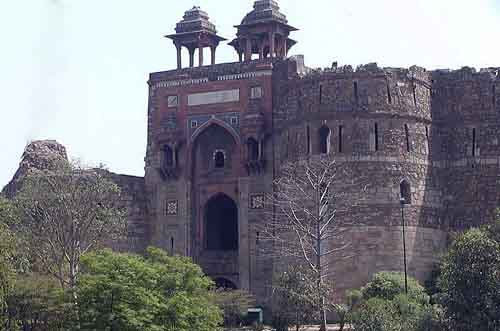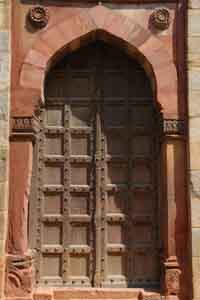|

click
for Other
Tourist
Place
|
Purana Quila
 Covering a circuit of about
a mile, the walls of the fort have three gates and are surrounded by a
mat fed by the river Yamuna.
Covering a circuit of about
a mile, the walls of the fort have three gates and are surrounded by a
mat fed by the river Yamuna.
The wall was built by Humayun
while the buildings in the fort are attributed to Sher Shar. The notable
buildings that have survived in the fort are the Sher Mandal and the Quila-I-kholina
Mosque. Sher Mandal is a two storeyed octagonal tower which was used by
Humayun as his library. The mosque, built around 1541-42, is a landmark
in Indo Islamic architecture.
The architect has shown skill
by enriching each part with moulding, bracketed openings, marble inlay,
carving and other establishments. A variety of materials have also been
used to construct the small mosque (168 x 44 feet). The entrance arch is
of marble, the spandrels of red sandstone studded with marble bossed, the
columns and pilasters of black and white marble.
Old Fort popularly known
as Purana Qila is noted for its massive walls and three large gateways.
The walls are 18 m high at some points. Humayun Darwaza, Talaqi Darwaza
and Bara Darwaza are the three gates of Purana Qila and today the entrance
is through the Bara Darwaza. Sher Mandal a small octagonal red sandstone
tower inside the Purana Quila was used by Humayun as a library. Historians
believe that the fort marked the site of Indraprastha, the capital of Pandavas.
Kuhna Masjid, built by Sher Shah with marble and red sandstone, is also
located inside the fort.
The Purana Qila built on
an ancient mound, perhaps conceals the ruins of the city of Indraprastha
of Mahabharata story. Archaeologists carried out excavations at the Purana
Qila from the 1950's to the 1970's. The excavations showed that the
Purana Qila was indeed a very old site. Archaeologists found that the settlement
had many phases dating from about the fourth century B.C. (or earlier)
to the nineteenth century A.D. Pieces of old pottery known as Painted Grey
Ware were also found and this suggested that people may have
lived at some spot in or around the Purana Qila from about 1000 B.C. onwards
Sher Shah Suri demolished the city of Dinpanah built by Humayun and on
the same site raised this citadel. It is believed that Sher Shah left the
Purana-Qila unfinished, and Humayun completed it. Among the scribblings
in ink that existed in a recess of the gate, there was a mention of Humayun,
and it is possible, therefore, that if the gate was not constructed by
Humayun, it was at least repaired by him. In the southern gate, which is
called the Humayun-Darwaza, there existed a similar inscription in ink
mentioning Sher Shah and the date 950 A.H. (1543-44).
BARA DARWAJA
There are three Gates to
this fort. Today entrance is through the Bara Darwaza. The South Gate is
called the Humayun Darwaza, probably because Humayun built it or because
the tomb of Humayun is visible from here. The third gate is the Talaqi
Darwaza.
It is believed that this
place was Indraprastha the capital city of Pandavas. Many of the present
standing monuments were built during the period of Sher Shah Suri. The
double-storied octagonal towered mosque is cited in history as the tower
from where, Emperor Humayun accidentally fell to his death. The lake at
the foothills has boating facilities. One does not have to go far to see
the Old Fort or Purana Quila standing stoically amidst wild greenary and
disintegrating ramparts.
The Purana Quila is roughly
rectangular in shape having a circuit of nearly two kilometres. The walls
are thick and the three gateways are provided with bastions on either side.
The northern gateway called the Talaqui Darwaza or the forbidden gateway
combines the typically Islamic pointed arch with Hindu chhattris and brackets.
Whereas the southern gateway, called the Humayun Darwaza, had a similar
parel with elephants. |
 |
|
Humayun who laid
the first brick of his new capital Dinapanah in 1534 built the massive
gateways and walls of Purana Quila. Sher Shah, who defeated Humayun in
1540, built a few buildings in the complex. Busy traffic runs along this
ancient defensive wall built by Sher Shah Suri. The fort, has massive walls
and three large gateways. There is a small octagonal red sandstone tower,
the Sher Mandal, inside the fort near the South gate. Humayun as a library
later used it. While descending the stairs of this tower one day in 1556,
he slipped, and received injuries from which he later died. The Qila-i-Kuhran
Mosque, or Mosque of Sher Shah, lies just beyond it. There's a small archaeological
museum just inside the main gate. There are good views of New Delhi from
atop the gate. |
|
|





